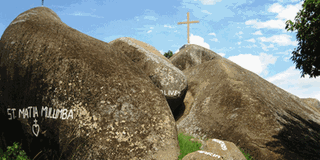Know Uganda: The making and history of Katoosa Martyrs Villa

Katoosa Martyrs villa in Kyenjojo District. Each of the different rocks bear inscriptions of the names of one of the 24 Uganda Martyrs. Photo by Geoffrey Mutegeki
What you need to know:
It was widely known as an evil place full of rocks but now it is a hub for Catholics and many other people from all walks of life because of the catholic martyr born in this parish.
Just a few meters on Kyenjojo-Kagadi road are rows of smooth round, cone-shaped brown beautiful rocks. This is Katoosa Martyrs Villa, an amazingly beautiful place in Kyenjojo Town just after Tooro Royal cottages hotel.
Known by the village in which it is located, rather than its patron saint, Adolf Tibeyalirwa Ludigo Abwooli, Katoosa Martyrs villa is a place that has attracted many visitors and pilgrims and its rocks are a site in memory of the 24 Ugandan martyrs killed by Kabaka Mwanga in 1880s.
The rocks which bear inscriptions of the martyrs, their names and dates of murder, gives the place a splendid look with rocks leaning on each other and others standing higher than the trees.
The villa which has over 30 rocks was established after the Catholics of Fort Portal Diocese came to know that St Adolf Tibeyalirwa was from Katoosa Parish in Kyenjojo District. Tibeyalirwa is among the 24 Ugandan martyrs killed by Kabaka Mwanga in 1880’s.
The myth in its history
“As we grew up, this place was full of witchcraft and was used by evil people who used to sacrifice people and do all sorts of evil, but since it was taken over by the Catholic Church, it has turned out to be one of the holy places in the country,” says John Bosco Rukoobemaango, the head of the laity at Katoosa parish.
The Katoosa parish priest, Rev Fr Moses Mutangirizi, says the shrine was established in the 1960s by Msgnr Francis Kibira who was given responsibility by the Uganda Episcopal Conference to start it up in respect of St Adolf Tibeyalirwa.
Due to old age, Kibira handed the work to Msgnr Hilarious Kaijanabyo who bought the land from the traditionalists who were using it for ritual purposes.
“It was not part of the church land and some people were using it for traditional religion. He bought it and dedicated every stone to the martyrs,” Mutangirizi explains.
Rukoobemaango explains that Msgnr Kaijanabyo asked the witches who were using the place to vacate it.
The church then declared the place holy and inscribed names of the Uganda Martyrs on the stones.
“Some people think we Catholics pray to these stones, but we don’t pray through them to get blessings from God. I have continued praying through St Matia Mulumba, the patron of matrimony and have managed to spend over 36 years in holy matrimony with my beloved wife have continued praying through St Matia Mulumba, the patron of matrimony and managed to spend over 36 years in holy matrimony with my beloved wife and we are still going strong,” Rukoobemaango says.
The villa which is two kilometres off the main Kampala-Fort Portal highway has over 30 stones which have inscriptions of Uganda martyrs and other religious inscriptions like, Jesus’s Tomb, Bethlehem.
Other stones are labelled with the events that took place during the coming of religion to Uganda and the events that surrounded the killing of the martyrs.
One of the stones is named Mwangas’s seat. It is a small stone in shape of a chair which is between two long standing stones.
Kabaka Mwanga of Buganda is famous for the killing of the Uganda Martyrs who disobeyed him and followed the White stones. Kabaka Mwanga is famous for the killing of the Uganda Martyrs who disobeyed him and followed the White man.
Every stone has an inscription of a martyr describing how he was killed, the place where he was killed from and his spiritual duty.
“Everyone comes and prays to his martyr depending on what he or she needs, every martyr is a patron for a different issue and one prays through his or her patron to communicate to God,” Rukoobemaango reveals.
Tibeyalirwa was abducted with his mother Kajoote around 1850 from his home village of Kyarwehikyo a few miles from the Katoosa rocks.
Rukoobemaango explains that Tibeyalirwa got the name Ludigo from the palace. Each year on November 27, Catholics from this region, Tanzania and Rwanda trek and gather at this site to pray and get blessings. It is said in the past when marriage ceremonies used to be conducted at night as a tradition in Tooro, brides were moved at night to the bridegroom’s home.
On one night, the bride and groom were passing at Katoosa and the bride ran away and entered one of the stones which isbelieved to have swallowed her and since then she has never been seen.
“This place was full of evil spirits in the past, everybody used to fear passing here and people in the past stopped taking brides through Katoosa,” Rukoobemaango explains.
Rev Mutangirizi explains that many tourists visit the place but are not charged as some come for prayers so you cannot charge someone for praying.
“We do not charge people any money but for those who come, we encourage them to contribute towards the development of the place,” says Mutangirizi, adding: “The place is open to everyone as long as you use it in the right way.”




